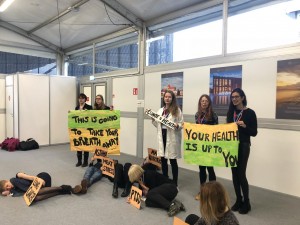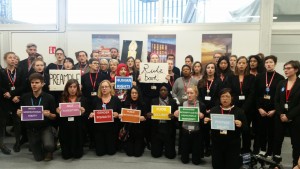Over the week there have been several protests in and around the COP to bring attention to certain issues that should be addressed in the Negotiations. Yesterday, Friday, Shana and I actually got to participate in a protest chanting “Climate equals Health, Our Health is up to you” to ensure that more public health issues are directly addressed in countries’ nationally determined contributions (NDC). While Shana is a tried and tested protester, this was my first time actually participating in a protest (rather than just observing one) and I was pretty proud of myself for pushing the boundaries of my comfort zone and try to make a difference.
But that got me thinking. How effective are protests at the COP actually? This year’s protests in Poland are more restricted than they have been in the past and one needs to have the protest approved and no microphones are allowed. Regardless of the extra restrictions with this year’s protester’s abilities, I think protests in general add a totally different dynamic to the COP. The negotiations I have been to at the COP have more so been about the language used in various agreements rather than debates about what should or should not be directly addressed. Furthermore, even if a specific issue were being added to the agreement, I have the distinct impression that the debates between states would generally agree that the issue should be included but would argue about the language of the agreement to the extent where it would end up being as vague as possible so that countries do not have to necessarily act upon said issue. To what extent does a protest really force countries to change the language of an agreement? Does it matter how many people and the type of people who get involved?
The three protests I attended during my time at the COP were all very different from one another.
A protest on Tuesday organised by SustainUS to Keep Fossils in the Ground! had around 20 people in the protest surrounded by 30 or so people watching the protest, most of whom I thought were young people. There was a lot of chanting, various people speaking about their personal experiences with fossil fuels, and while the audience was pretty big, it did not get much bigger. This protest was quickly followed by an organised Press Conference that concisely defined the movement’s demands. A protest on Friday on Human Rights had a similar atmosphere around it in terms of the people that were there but there was a lot more silence than chanting. Furthermore everyone from that protest was wearing black and had red lanyards for the entire day to continue their protest.
Finally, the protest I actually participated in, also on Friday, about Climate Change and Health did not have that many participants, nor that big of an audience. We played out a skit and then did some chants but there was not a speech of what we were actually demanding which I thought could have really helped others understand the goals of the protest. Although the audience was not very big, I did think that because we were not completely blocking off a hallway, that people walking past could actually see our protest rather than having to walk past a big herd of people who are encircling the protest and thus are also obstructing the ability for passers by to see the protest. We did get press coverage by a couple of country’s news outlets (and by a couple, I mean exactly 3) but it is difficult to tell the effect of the news coverage on important COP negotiations too.
The primary goals of all these protests at COP are to change the way that the agreements are being negotiated and in order for that to happen, the actual negotiators should be listening. Are they really listening though? There are long negotiations continuously throughout the day so when would a delegate even have time to see the protest? A lot of the issues brought up in these processes are further talked about in side events and press conferences, but again, most state representatives are too busy to go to these meetings (I certainly haven’t seen many of them at the events I went to). Many states have prepared for weeks in advance their specific strategies of negotiating deals and have specific orders of what the outcomes should be at the end of the two weeks. Thus, how would an impromptu protest change a state’s stance on the climate negotiation?
Protests do have an impact, I’m not denying that. But I do wonder whether protests are the right way to make an impact at the COP. The protests I have seen have all been organized by young people and it seems that at the COP, protests are the only way in which non-governmental organizers (especially YOUNGOs) can make their voices heard since they are prohibited from even entering high level negotiations. I believe that the questions posed here are definitely worth looking into and I think that in addressing them, people could make their protests more effective.

I think it is really cool how you guys are changing the world
Hi Henri, I guess I think we are all changing the world every day–but you mean you like the protests because they seem to be a way of shifting action into a better direction. Is that right? Yesterday, there was a big protest at a US presentation on “clean coal” (which is not very clean, though “scrubbers” for coal plants would remove mercury from the air and there are a lot of coal plants still in operation, and more being built). Anyway, I don’t think anyone thought this presentation was a good way forward, especially not because the US is also refusing to “welcome” the IPCC special report that says we have to do a lot more a lot sooner. So many people stood up and shouted and sang and marched to interrupt the panel. It was pretty loud and pretty exciting. I’ll try to post a video later today.
Thanks for sharing! Its certainly difficult to balance.
I remember at COP 21 there were a lot of strong, emotional, clear, and clever protests and demonstrations. Two particular points of emphasis were on the 1.5 degree target, which did get into the final text (“one point five to stay alive!”) and to include options loss and reparation suits against polluter nations, which was specifically prohibited in the final text.
On the other hand, I saw some demonstrations like this, with three people in some bad star wars costumes that got swarmed by a huge crowd of about thirty people with giant cameras taking video for as many news outlets. Win some lose some.
https://www.yahoo.com/news/campaigning-adventurers-converge-paris-climate-talks-160747709.html
Nathan, I agree that the media response to things here seems more driven by media needs than by a focus on the most important issues. But over the course of the week, I have been increasingly convinced that the Parties and the structure of the UNFCCC are not going to be the source of any pathbreaking solution. (I know, I know–this has been obvious for years, but watching the negotiations here has been a sobering experience.) On the other side, I have been impressed by the intelligence-gathering and organizational skills of groups like ECO and Climate Action Network. Some of the small island developing states and least developing countries are pointing to movements like Sunrise and Extinction Rebellion as the best hope for progress toward a livable future.